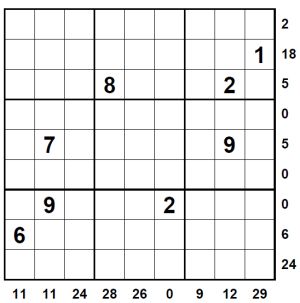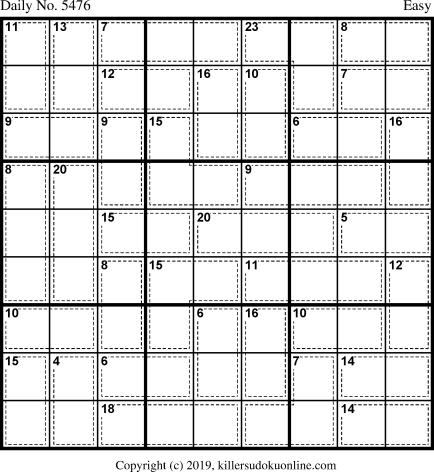A sudoku solver using Z3 Theorem Prover.
- Classic (This is the regular sudoku with no extra constraints)
- Chess (Knight, King, and Queen)
- Miracle (No consecutive neighbors + King + Knight)
- Thermo (Cells on thermometer must be increasing)
- Sandwich (Hints provided are the sums between the one and the nine in row/column)
- Killer (Cages have sums with no repeating digits)
- Any combination of the above (see section Sudoku File Format below)
First install the Python wrapper for Z3 from pypi using the command
pip3 install z3-solverThen just pass in the sudoku puzzle file as the only argument
python3 sudoku.py puzzles/thermo_0.sudokuThe .sudoku file provided to the script should be formatted as described:
- A regular ASCII formatted text file
- Whitespaces (newline, space, tab, etc) are ignored
- The first 81 characters (excluding whitespaces) should contain the known digits [0-9] and a dot
.in places of an empty/unknown cell. - An optional semicolon
;separated list of zero or more constraints to apply (trailing semicolon optional) - Letters in constraints are case-insesitive (I think)
Each constraint is formatted as: <TYPE><OPTIONS>
The miracle and the chess constraints take no options and are applied to the entire grid.
Example sudoku files can be found in the puzzles/ directory.
Empty constraints list.
No extra constraints applied in addition to the basic sudoku rules (Classic sudoku)
In a thermo sudoku, there are these thermometers drawn from one cell to another.
Digits on these thermometers must increase from the bulb end to the other end (doesn't have to be consecutive).
Type is T, which is followed by a list of pairs of digits representing the row-column numbers in the order of the thermometer.
Note: Row and column numbers start from 1 (as opposed to 0) and from the top left corner.
Example:
For the given thermo sudoku below (from https://maybepuzzles.com/types/thermo-sudoku/)
The top-left thermometer starts from row 2 column 1 (2,1) and continues to (1,2) (2,3) (3,2), which would result in the constraint string T21232332
(also can be written as T 21 12 23 32 since whitespaces are ignored)
The bottom-right thermometer is then T98877889
The resulting sudoku file then looks like:
... .2.
... 5.1
... .6.
.4. ...
5.3 ...
.2. ...
T21232332;
T98877889
(I just realized this isn't a full 9-by-9 sudoku, but hopefully you get the idea)
Type is KN, Q, or K depending on whether it's knight, queen, or king, respectively.
No extra options are needed.
Example:
(from puzzles/knight_0.sudoku)
..3 6.8 1..
.4. ... .7.
2.. ... ..3
6.. .9. ..8
... 1.2 ...
7.. .6. ..4
4.. ... ..1
.6. ... .2.
..5 4.9 8..
KN
Miracle sudoku is a combination of what I call "consecutive neighbors" + knight + king constraints.
This means that, on top of the knight's and king's constraints, "any two orthogonally adjacent cells cannot contain consecutive digits."
Similarly to the chess constraints above, no extra options are needed.
Example:
(from puzzles/miracle_0.sudoku)
... ... ...
... ... ...
... ... ...
... ... ...
..1 ... ...
... ... 2..
... ... ...
... ... ...
... ... ...
M
In a sandwich sudoku, there are hints provided outside of the grid next to a row or a column.
These hints are the sums of the digits between the 1 and the 9 in that corresponding row or column, referred to as the "sandwich sum".
The type is S, combined with either R or C for row or column, respectively.
Then comes the row/column number from 1 to 9, followed by the sandwich sum.
Example:
For the given sandwich sudoku below (from http://www.clarity-media.co.uk/puzzleblog/sandwich-sudoku-puzzles)
Row 1 has the sandwich sum of 2, which can be written as SR12.
Column 5 has the sandwich sum of 26, which can be written as SC526.
In a killer sudoku, the cells are enclosed in a cage, where the digits cannot repeat and sum up to the "cage sum" hint given in the top left corner.
The type is C, which is followed by the sum (0 padded two digits; 1 is 01, 7 is 07, 45 is 45) and then the list of the cells in the cage, in the form of row-column number pairs, similarly to the thermo constraints
Note: Row and column numbers start from 1 (as opposed to 0) and from the top left corner.
Example:
For the given killer sudoku below (from https://www.killersudokuonline.com/play.html?puzzle=D3s4r2g5463&year=2020)
The top-left cage sums up to 11 and contains cells (1,1) and (2,1), which is written as C11 11 21
The 7 cage in boxes 8 and 9 is then C07 87 97 96
These are some of the features I want to add:
- Better display of input puzzle (how to show the extra constraints)
- Option to find ALL possible solutions (helpful for puzzle creation in verifying unique solution)
- Probably optimize some of the constraints using Z3 functions
- Show steps (possible to do with Z3?)
- Original work from Giuseppe Cardone's blog post
- Similar work Solving Sudoku Puzzles By Algorithms
- Similar project by me to solve another sudoku-like puzzles Jane Street Puzzles - Dec 2020
- Z3 - Guide
- Programming Z3 (Python)



